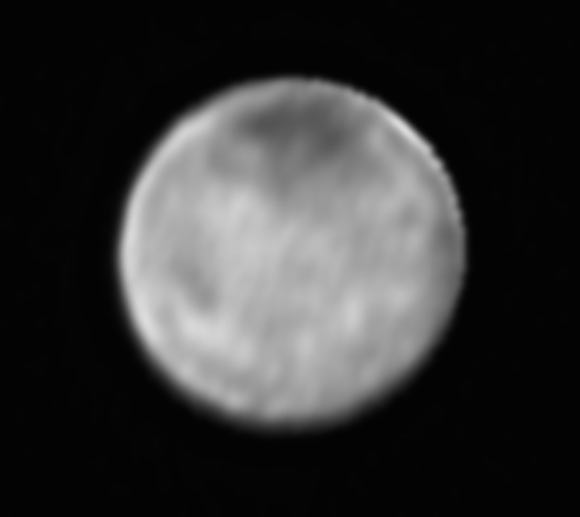NASA’s New Horizons space probe, which will do a close flyby of the Pluto system on July 14, has sent back a new image of Charon, the largest of Pluto’s five moons.

New Horizons was about 3.7 million miles (6 million km) from Charon when it snapped this image on July 8, 2015. Image credit: NASA / Johns Hopkins University Applied Physics Laboratory / Southwest Research Institute.
Charon was discovered on April 13, 1978 by American astronomer James Christy. The icy moon has a diameter of about 750 miles (1,207 km), almost half the size of Pluto.
The moon is so big that Charon and Pluto are sometimes referred to as a binary dwarf planet.
However, Charon weighs only 12 percent as much as Pluto. This suggests that the moon may be half ice and half rock.
Unlike Pluto, which is surrounded by a thin envelope of nitrogen, methane and carbon monoxide gases, Charon seems to have no atmosphere. Charon’s surface is made of frozen water and ammonia compounds.
Pluto and Charon are tidally locked, circling their common center of gravity once every 6.4 days. As a result, an astronaut on Pluto’s surface would always see the moon in the same part of the sky, but appearing seven times larger than Earth’s Moon, spanning 3.5 degrees on the sky.
The smaller size and lower surface contrast of Charon have made it harder for the New Horizons spacecraft to capture its surface features from afar, but the latest, closer image of Charon’s surface show intriguing fine details.
Newly-revealed are brighter areas on Charon that planetary scientists with the New Horizons mission suspect might be impact craters. If so, the researchers would put them to good use.
“If we see impact craters on Charon, it will help us see what’s hidden beneath the surface. Large craters can excavate material from several miles down and reveal the composition of the interior,” said team member Dr Jeff Moore of NASA’s Ames Research Center.
“Charon is now emerging as its own world. Its personality is beginning to really reveal itself.”







